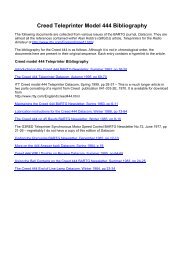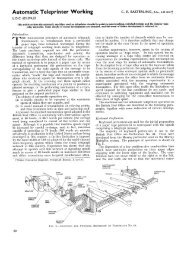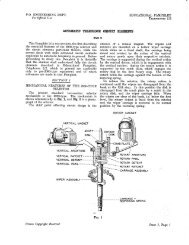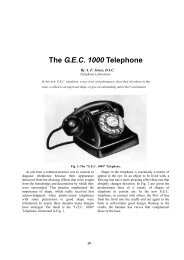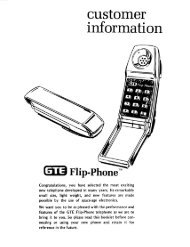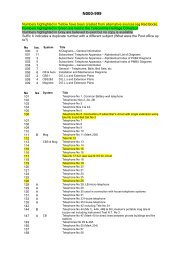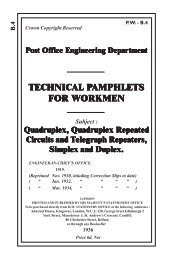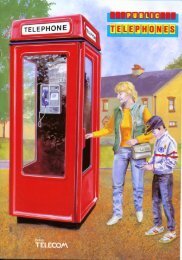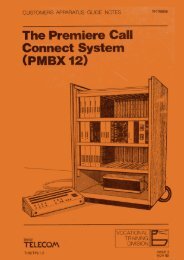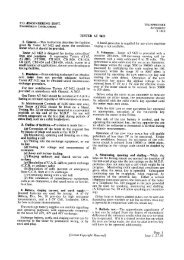TRAFFIC CONTROL TELEPHONE SYSTEMS Circuit - Sam Hallas
TRAFFIC CONTROL TELEPHONE SYSTEMS Circuit - Sam Hallas
TRAFFIC CONTROL TELEPHONE SYSTEMS Circuit - Sam Hallas
You also want an ePaper? Increase the reach of your titles
YUMPU automatically turns print PDFs into web optimized ePapers that Google loves.
Page 22<br />
Thus:<br />
17 minus (1st digit + 3rd digit) = 2nd digit.<br />
= 17 minus (3 + 3) = 11 impulses.<br />
Commencing at the 17th impulse K1, 2 and 3 are in contact for a period of 2 to<br />
3 seconds during the ringing period, then K1 and 2 open, but K1 and 3 remain in<br />
contact, holding the battery relay until the key arrives at the normal position. On the<br />
opening of K1, K2 contacts the reversing relay is de-energised and an impulse is<br />
transmitted which releases the selector called and any other selector which may have<br />
held on an intermediate code pin. When the key arrives at the normal position and K1,<br />
K3 open, the battery relay is released and an ineffective impulse is transmitted. The<br />
system is now at normal and ready for further calls.<br />
General Call<br />
To set the key to call all stations seventeen uninterrupted impulses are sent to<br />
line. These impulses advance all selectors, irrespective of the position of their code<br />
pins, to the 17th step which is the ringing position. Thus the call bells at all Way<br />
Stations are energised calling all the operators.<br />
This is done by using two flat segments bridging all teeth from the top of the<br />
ninth tooth to the ringing position.<br />
Time Sending<br />
In this case 22 successive impulses are transmitted which advance all selectors<br />
to the time bar. To do this use a flat segment bridging from the centre of the first tooth<br />
to the centre of the fourth tooth.<br />
Mechanical Requirements for Maintenance Purposes<br />
1. The main spring M and shafts where exposed, should be greased lightly with<br />
petroleum jelly to Standard Spec. 50518. Appendix No. 1.<br />
2. Pinions to be very lightly oiled with oil dag to Standard Spec. 50227.<br />
3. Governor bearings to be very lightly lubricated with clock oil to Spec. 57544<br />
Grade 2.<br />
N.B. - It is important that this should be done carefully, as any oil on the<br />
governor weights will affect the speed of the key.<br />
As a guide to what is intended by the term "very lightly oiled" the following<br />
definition will be of assistance.<br />
"To apply oil very lightly, insert a pointed match-stick in the oil and allow the<br />
amount of oil picked up by the match-stick to drain on the part to be lubricated."<br />
We suggest that oiling is made a routine job every three months.<br />
The above mentioned oils are obtainable from Standard Telephones and Cables<br />
Ltd. in 1 pint, 2 pint, ½ and 1 gallon cans.



